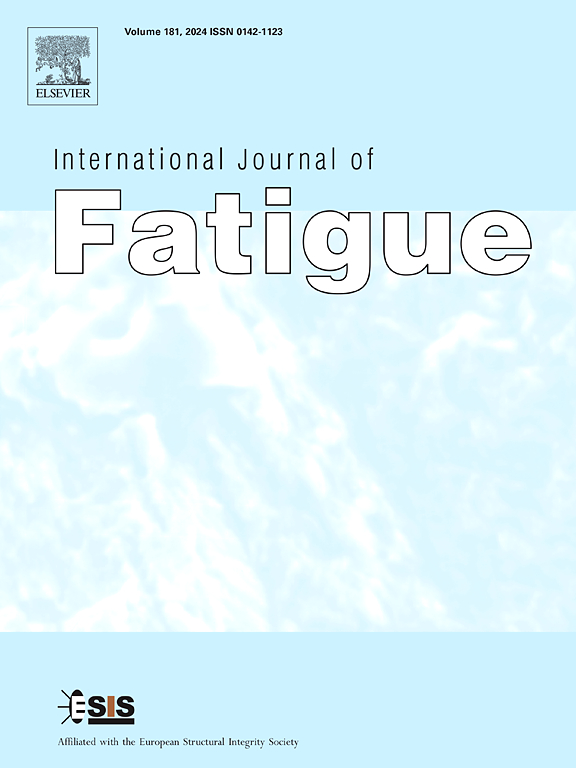Pre-corrosion very-high-cycle AI-fatigue in completion string
IF 5.7
2区 材料科学
Q1 ENGINEERING, MECHANICAL
引用次数: 0
Abstract
The very-high-cycle fatigue (VHCF) behavior of material BG2532, used in oil and gas completion strings, was investigated under both non-corrosive and hydrogen sulfide (H2S) gas corrosion conditions. During the experiment, the material’s fatigue property and fatigue fracture characteristics were studied. Additionally, the microstructure on the axial cross-section, perpendicular to the fatigue fracture surface, was analyzed to explore the mechanism of corrosion-induced VHCF crack initiation. To enable unified VHCF life prediction for the material under both corrosive and non-corrosive conditions, different VHCF life prediction models were developed. Fatigue fracture characteristics, including the number of grains per unit area on fatigue source and the facet ratio on propagation area, were proposed as key parameters for VHCF modeling. Two artificial intelligence (AI)-fatigue models incorporating corrosion effects were developed and compared. The results show that integrating fatigue source and propagation characteristics using deep learning and convolutional neural networks significantly enhances the accuracy of VHCF life predictions, with errors remaining within a factor of two. This model effectively predicts the VHCF life of BG2532 alloy under both corrosive and non-corrosive conditions.
完井管柱的预腐蚀高周期ai疲劳
在非腐蚀性和硫化氢(H2S)气体腐蚀条件下,研究了油气完井管柱中使用的BG2532材料的甚高周疲劳(VHCF)行为。实验过程中,对材料的疲劳性能和疲劳断裂特性进行了研究。此外,还分析了垂直于疲劳断口的轴向截面上的微观组织,探讨了腐蚀诱发VHCF裂纹的起裂机理。为了对材料在腐蚀和非腐蚀条件下进行统一的VHCF寿命预测,开发了不同的VHCF寿命预测模型。提出了疲劳断裂特征,包括疲劳源上单位面积的晶粒数和扩展区域的小面比,作为VHCF建模的关键参数。建立并比较了两种考虑腐蚀效应的人工智能疲劳模型。结果表明,使用深度学习和卷积神经网络集成疲劳源和传播特性可以显著提高VHCF寿命预测的准确性,误差保持在2个因子以内。该模型有效地预测了BG2532合金在腐蚀和非腐蚀条件下的VHCF寿命。
本文章由计算机程序翻译,如有差异,请以英文原文为准。
求助全文
约1分钟内获得全文
求助全文
来源期刊

International Journal of Fatigue
工程技术-材料科学:综合
CiteScore
10.70
自引率
21.70%
发文量
619
审稿时长
58 days
期刊介绍:
Typical subjects discussed in International Journal of Fatigue address:
Novel fatigue testing and characterization methods (new kinds of fatigue tests, critical evaluation of existing methods, in situ measurement of fatigue degradation, non-contact field measurements)
Multiaxial fatigue and complex loading effects of materials and structures, exploring state-of-the-art concepts in degradation under cyclic loading
Fatigue in the very high cycle regime, including failure mode transitions from surface to subsurface, effects of surface treatment, processing, and loading conditions
Modeling (including degradation processes and related driving forces, multiscale/multi-resolution methods, computational hierarchical and concurrent methods for coupled component and material responses, novel methods for notch root analysis, fracture mechanics, damage mechanics, crack growth kinetics, life prediction and durability, and prediction of stochastic fatigue behavior reflecting microstructure and service conditions)
Models for early stages of fatigue crack formation and growth that explicitly consider microstructure and relevant materials science aspects
Understanding the influence or manufacturing and processing route on fatigue degradation, and embedding this understanding in more predictive schemes for mitigation and design against fatigue
Prognosis and damage state awareness (including sensors, monitoring, methodology, interactive control, accelerated methods, data interpretation)
Applications of technologies associated with fatigue and their implications for structural integrity and reliability. This includes issues related to design, operation and maintenance, i.e., life cycle engineering
Smart materials and structures that can sense and mitigate fatigue degradation
Fatigue of devices and structures at small scales, including effects of process route and surfaces/interfaces.
 求助内容:
求助内容: 应助结果提醒方式:
应助结果提醒方式:


